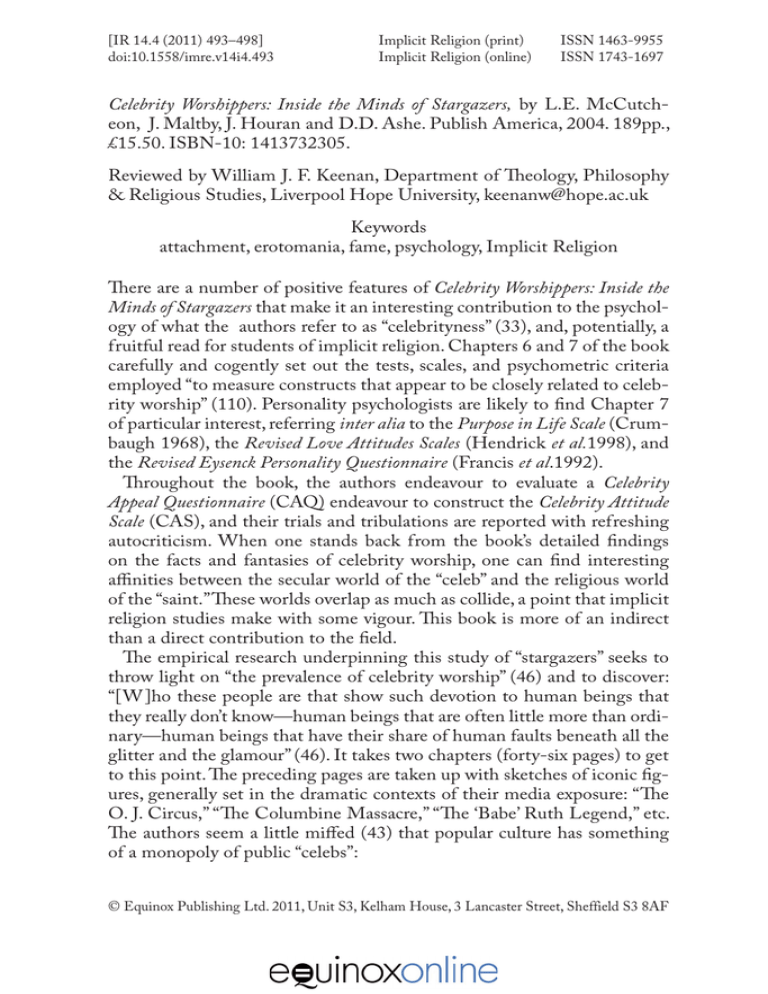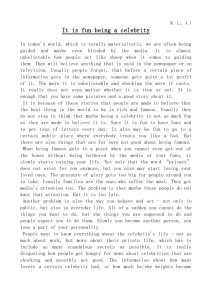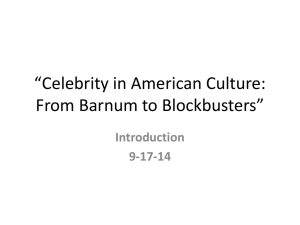Celebrity Worshippers: Inside the Minds of
advertisement

[IR 14.4 (2011) 493–498] doi:10.1558/imre.v14i4.493 Implicit Religion (print) Implicit Religion (online) ISSN 1463-9955 ISSN 1743-1697 Celebrity Worshippers: Inside the Minds of Stargazers, by L.E. McCutcheon, J. Maltby, J. Houran and D.D. Ashe. Publish America, 2004. 189pp., £15.50. ISBN-10: 1413732305. Reviewed by William J. F. Keenan, Department of Theology, Philosophy & Religious Studies, Liverpool Hope University, keenanw@hope.ac.uk Keywords attachment, erotomania, fame, psychology, Implicit Religion There are a number of positive features of Celebrity Worshippers: Inside the Minds of Stargazers that make it an interesting contribution to the psychology of what the authors refer to as “celebrityness” (33), and, potentially, a fruitful read for students of implicit religion. Chapters 6 and 7 of the book carefully and cogently set out the tests, scales, and psychometric criteria employed “to measure constructs that appear to be closely related to celebrity worship” (110). Personality psychologists are likely to find Chapter 7 of particular interest, referring inter alia to the Purpose in Life Scale (Crumbaugh 1968), the Revised Love Attitudes Scales (Hendrick et al.1998), and the Revised Eysenck Personality Questionnaire (Francis et al.1992). Throughout the book, the authors endeavour to evaluate a Celebrity Appeal Questionnaire (CAQ) endeavour to construct the Celebrity Attitude Scale (CAS), and their trials and tribulations are reported with refreshing autocriticism. When one stands back from the book’s detailed findings on the facts and fantasies of celebrity worship, one can find interesting affinities between the secular world of the “celeb” and the religious world of the “saint.” These worlds overlap as much as collide, a point that implicit religion studies make with some vigour. This book is more of an indirect than a direct contribution to the field. The empirical research underpinning this study of “stargazers” seeks to throw light on “the prevalence of celebrity worship” (46) and to discover: “[W]ho these people are that show such devotion to human beings that they really don’t know—human beings that are often little more than ordinary—human beings that have their share of human faults beneath all the glitter and the glamour” (46). It takes two chapters (forty-six pages) to get to this point. The preceding pages are taken up with sketches of iconic figures, generally set in the dramatic contexts of their media exposure: “The O. J. Circus,” “The Columbine Massacre,” “The ‘Babe’ Ruth Legend,” etc. The authors seem a little miffed (43) that popular culture has something of a monopoly of public “celebs”: © Equinox Publishing Ltd. 2011, Unit S3, Kelham House, 3 Lancaster Street, Sheffield S3 8AF 494 Book Reviews Ask your kids who their heroes and heroines are. We think they will give you a list of athletes and entertainers. Our guess is that very few people on their lists will be people who went out of their way to do something wonderful to help others. How many scientists and humanitarians will be among their heroes? The research on which the book is based is from a series of studies carried out by a number of the authorial team using their Celebrity Attitude Scale. For example, about 36% of the 600 British adults surveyed scored above the midpoint of the scale, thus indicating strong celebrity attachment (Maltby, Houran and McCutcheon 2003). Though the finding per se was not unexpected, the “media frenzy,” as the authors put it (24), that followed its publication, was unexpected. “Media worship” entered the psychological lexicon at the same moment as it became a public concern. In chapters 4 and 5, the book provides overviews of published studies of the phenomenon. Their summary of these includes the following (93): Attempts to link loneliness to celebrity adulation have only been marginally successful … The relationship between sports hero worship and age is a negative one. However, there is a positive relationship between parasocial attraction to a newscaster and age … older participants were less likely to select favourite celebrities from entertainment categories … Little support was found for a connection between social class and being a sports fan … There is some indication that fans of entertainers tend to be introverted and imaginative …The most dedicated fans tend to exhibit attitudes which suggest they have unmet needs. Some fans appear to be seriously disturbed, but attempts to distinguish the dangerous from those who are merely harmlessly deranged have proven surprisingly unsuccessful. Chapter 6 opens with a sideswipe at this published inheritance (95): “[A] fair amount has been written about celebrity worship.Unfortunately, much of it amounts to little more than speculation, mixed with a few casual observations and sprinkled liberally with anecdotes.” I must confess to a feeling that this described aspects of the book under review, at least up to this point. So I was looking forward to the authors’ improved scientific contribution in the remaining chapters. They write (95): “We need to determine the relevant dimensions of celebrity worship, and demonstrate that our instruments meet or exceed the psychometric criteria used by psychologists to evaluate attitudinal scales.” Then follows a lesson on reliability testing, validity, factor analysis etc., with the remaining fifteen pages of chapter 6 devoted to outlining the general characteristics of the scales, inventories and questionnaire designs that were employed by the authors. This is useful stuff for an undergraduate textbook, but comes perhaps a bit © Equinox Publishing Ltd. 2011 Book Reviews 495 late in the day in a publication such as this. Chapter 7 specifies exactly how the scales were fine-tuned for the purposes of exploring “what celebrity worshippers are really like and why they think and act as they do” (113). But the motivational framework for this fame work is hardly scientific, in the (conventional) value-free, objective, detached sense. The authors comment (113): As noted in the first part of chapter one, the impetus for much of this work was our amazement at the extraordinary amount of attention and adulation heaped upon people whose accomplishments hardly seem to merit a second glance. We were fascinated by people who appear to have nothing more important to do with their time than to genuflect every time one of their shallow gods made a public appearance. This language borders on disdain for the very cultural world that the scales, inventories and questionnaires are, reportedly, attuned to measure. The “view from above” here lacks both “street cred” and ethnographic verstehen. It underplays the research subjects’ reflexivity (45): In fact, our research suggests that many fans are fairly rational. They usually understand that their favorite celebrities are human beings who have human strengths and weaknesses… However, it is clear that many fans are not so rational. Their admiration crosses the psychological border into the previously uncharted territory of celebrity worship. In a McLuhan-Baudrillardian media-fixated world, we appear, somewhat paradoxically, to get anxious (or at least the authors of this book seem to do) if there are signs of “over-identification” (their word) with the powerful “stars” who make that world go round. Yet elites have traditionally been those towards whom deference is cultivated. Of course, it all depends on the meaning and measurement of that contentious little prefix, “over.” The book displays a great deal of careful and intricate negotiation and manipulation of the test machinery, to arrive at correlations that are suggestive of variability in the degrees of “one-way attachment.” The Celebrity Survey itself was administered to 262 persons living in central Florida, USA. The convenience sample was initially 215 persons; “[t]he additional 47 persons were added for the purposes of making the Rasch analysis … more robust.” Scores on the 23-item Celebrity Attitude Scale (CAS) appear to rise from 11 to age 16, peak in the late teens and gradually decline into adulthood. (The iconography of bedroom posters, T-shirts, tattoos and graffiti would no doubt support this statistical portrait.) The chapter proceeds to present the age, gender, marital status, employment status, educational level, etc, correlations. The key result here was the finding that © Equinox Publishing Ltd. 2011 496 Book Reviews “a celebrity system flourishes” (123), such that, “if you have strong feelings for your favourite celebrity you will be inclined to like other celebrities, as well. These results add support to the theory of interchangeable parts.” In a sense, the star system does for America what other (more “religiousy”) pantheons have done for other parts of the world, at least historically, in providing a unifying “sacred canopy.” Chapter 8 is the most “social psychological” of the chapters. It integrates the survey materials into the wider demographic and sociological picture. The starkest association was with race and ethnicity (143): “Black participants selected black celebrities as their favourites an overwhelming 81% of the time. That figure was nearly duplicated in reverse by white participants, who selected white celebrities 73% of the time.” Interestingly, the race correlation did not hold for Hispanics, who happen to be the fastest growing “demographic” in the USA, as well as the most religiously affiliated. But chapter 8 is also the most illuminating of the chapters on the personality correlates of celebrity worship (CW). Weak links are found between CW and shyness, loneliness, and authoritarianism. “Dependent lovers” and “game players” both exhibit stronger celebrity attachment than “practical lovers” (cf. Hendrick et al.’s Love Attitudes Scale, 1998). Fantasyproneness may be operational here, it seems: a further putative link with implicit religion and spirituality, perhaps. Arguably, the most salient finding of the entire study is that “noncelebrity worshippers appear to be smarter or more creative than celebrity worshippers. Smarter persons are more likely to grasp the idea that the main purpose of the celebrity system is to sell products” (151). But there may also be valuable “intrinsic” aspects of CW, which this “hermeneutic of suspicion” overlooks. Perhaps this text (like many in the social sciences of religion) suffers from the “intellectualist fallacy,” privileging cognition over faith? The book draws attention to the interesting concept of “erotomania,” the delusional belief that another person is passionately in love with the individual (152): “[I]t may be that celebrity worship and erotomania are related phenomena that derive from similar psychological needs or a common neuropsychological state.” (This would certainly be worth following up in the context of the love of God, given and received, experienced and perceived.) Correlational research suggests, inter alia, that female adolescents, “who have intense/personal feelings toward a celebrity with an attractive body shape, develop a poor body image” (154). It is instructive that within both native religions and world faiths, in contrast with the © Equinox Publishing Ltd. 2011 Book Reviews 497 secular modern fashion market, female worship figures, as role and body models (Madonnas of the shrine rather than the stage) come in a plentiful variety of shapes and sizes. The book endeavours to set the divergent findings of a series of previously published studies within a general theoretical framework. But this is bitty and unresolved. The “Absorption-Addiction Model” (154–163), utilized to account for “delusional beliefs” (163), in particular, needs to be set within a more nuanced, broader-based hermeneutic. (In the context of implicit religion studies, notions of “delusional beliefs” might appear highly suspect. Perhaps a distinction needs to be drawn between “fans” and “fanatics,” in both religious and secular contexts.) Celebrity worship has considerable affinities with “secular religion,” and “religious religions” (to coin a phrase) might have much to learn about their own “addictives” from this study. However, there is an imbalance in the coverage of heroic figures, and their place in people’s lives. How diminished would many lives be without the wall posters, scrapbooks, and personal fantasy worlds populated by the likes of Rosa Parks, Mohammad Ali, Aung San Suu Kyi, Pele, Nelson Mandela, Bob Dylan, or Madonna (the material girl)? Carlyle’s classic study of hero worship (1841) would be an apt reference here. For the authors of Celebrity Worship, the inspirational, positive role-modelling influence of celebrities (who exist in the academic world, too, of course) can often become dysfunctional and unhealthy, notably for the impressionable, aspirational, obsessional and delusional. “Pathological” is the authors’ term for this quasi-religious fervour, occasioned, it appears, by the diminished emotional distance between larger-than-life fantasy figures of screen, stage, sports field (and, though less so, scientific symposium), and we (in the authors’ view) ordinary mortals. It is as if one were to assess the calibre of “religion” by focussing on its more fundamentalist, cultic and aberrant variants. But “magi,” at least in some religious narratives, have a reputation for wisdom, and the stars they follow have not always led to the heart of darkness. Perhaps the most revealing way of getting inside the mind of the authors of Celebrity Worshippers: Inside the Minds of Stargazers is to quote from their final page. They write (168): It may help if you understand that some celebrities marry their inflated egos to their ignorance and produce retarded offspring in the form of harmful advice ... We hope that this book has increased your level of awareness about celebrities and the potential problems that might accrue if you become “hung up” on them. © Equinox Publishing Ltd. 2011 498 Book Reviews Celebrity Worship teaches us to be wary, and rightly so, of the over-zealous, addictive and extremer forms of over-identification with public figures, and the loss of personal autonomy and discretion that may follow in certain cases. An interesting social scientific book remains to be written, however, on the positive side of this implicit religion equation. One can surely admire David Beckham, and even Posh Spice, without wishing to have quite so many hair do’s. References Carlyle, T. 1841. On Heroes, Hero-Worship, and the Heroic in History. London: James Fraser. Crumbaugh, J. 1968. “Purpose in Life Test.” Journal of Individual Psychology 24: 74–81. Francis, L.J., L.B. Brown and R. Philipchalk. 1992. “The Development of an Abbreviated Form of the Revised Eysenck Personality Questionnaire (Epqr-A). Its Use Among Students in England, Canada, the USA, and Australia.” Personality and Individual Differences 13: 443–449. Hendrick, C.S.S. Hendrick and A. Dicke. 1998. “The Love Attitudes Scale: Short Form.” Journal of Social and Personal Relationships 15: 147–159. Maltby, J., J. Houran and L.E. McCutcheon. 2003. “A Clinical Interpretation of Attitudes and Behaviors Associated with Celebrity Worship.” Journal of Nervous and Mental Disease 191: 25–29. © Equinox Publishing Ltd. 2011



